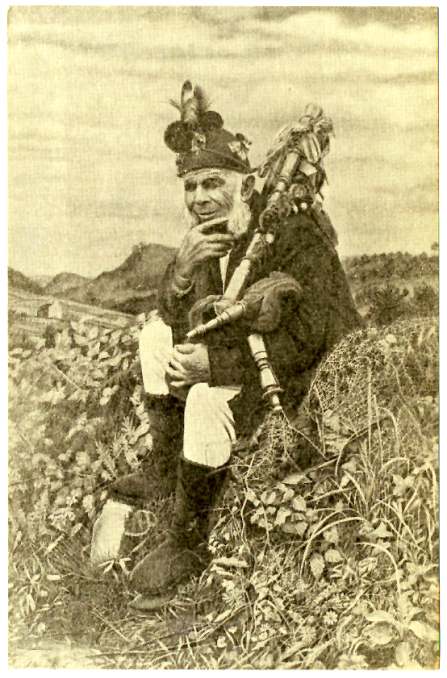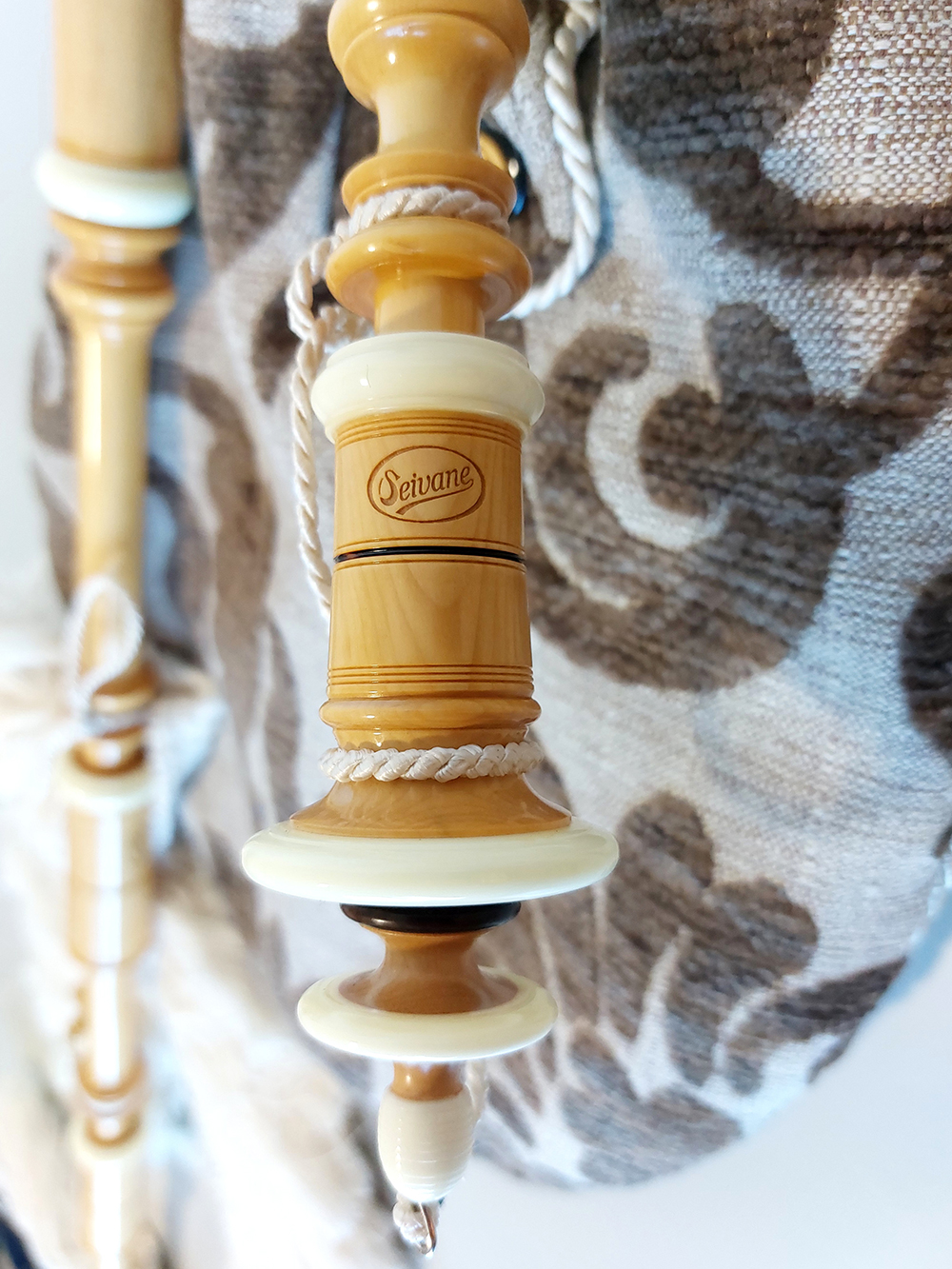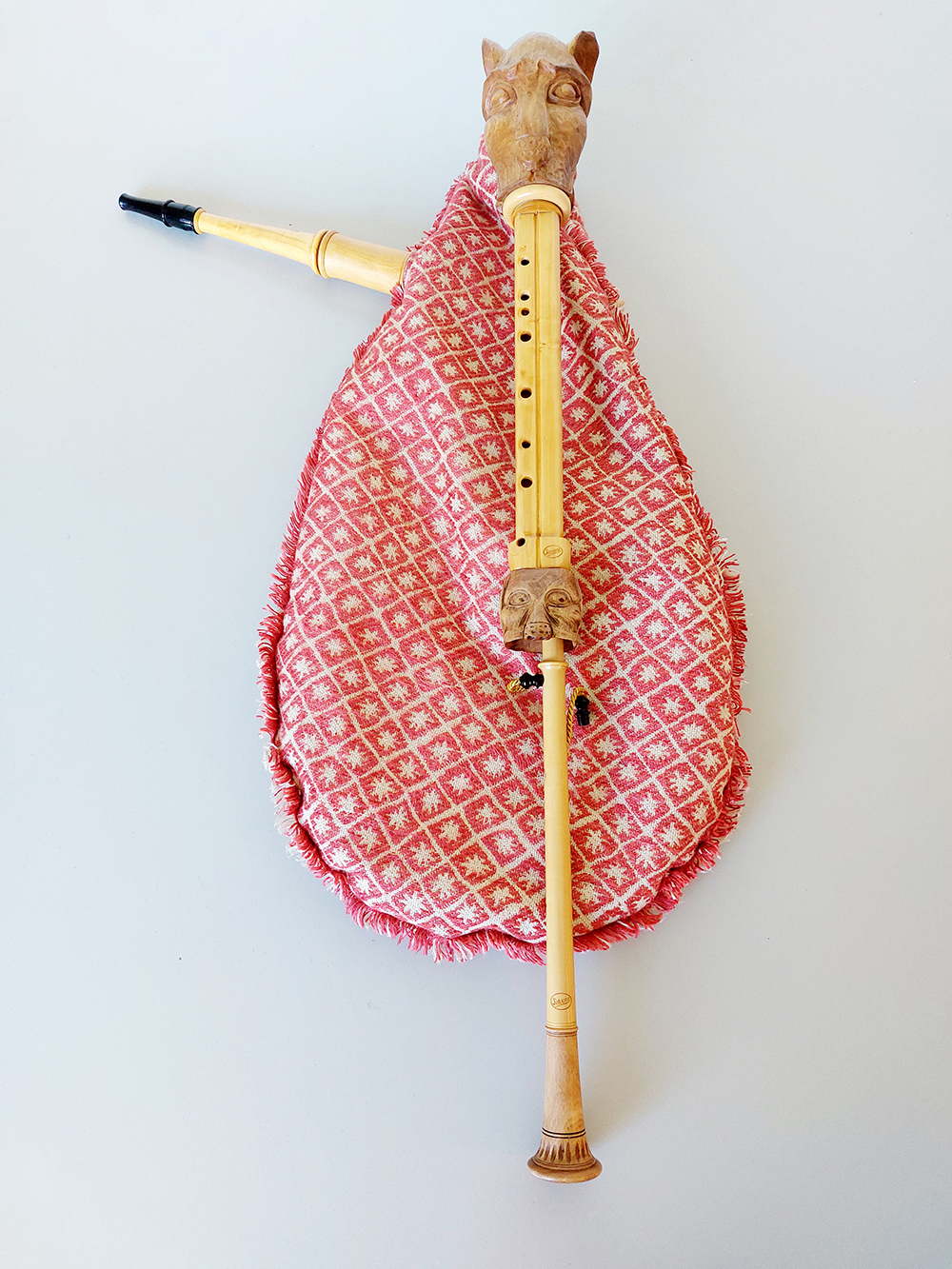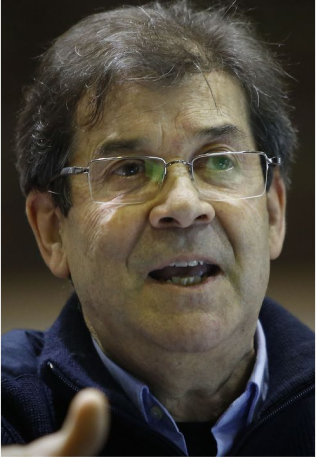History & Literature
According to the experts, it is likely that the gaita, as a cultural element with a possible Celtic origin, was introduced in Galicia long before the Christian age. However it was, the truth is that the gaita is as remote as our own history.
Origin and Importance
The age of its origin and the geographic boundary that it spans have, as a consequence, a progressive and vigorous adaptation to the means and cultures in which it is maintained alive.
It began as a chanter to which a bag was added to store air, in order to achieve a continuous sound that did not depend on air being blown directly into it. The bass drone appears in the IX Century and proved to be a great advance by providing a chanter with a bag a deep and constant pedal, which would be the basis for the derivation and evolution of different gaitas. In the case of the Galician gaita, it emits the chanter’s keynote but two octaves lower and develops its own identity by the Middle Ages.
Some time later the gaita, with its chanter and bass drone, has two more drones added: a high drone and tenor drone. After some hesitation about where to put them, popular wisdom ended up placing them where they are now: joined to the bag at the rear of the right hand side. This special availability of the three tonal pedals ensures that the instrument wraps around the bagpiper with its harmony and distinguishes and makes our bagpipe look unique compared to those of other geographical areas or cultures. The differences in the harmonious sound properties and the playing techniques are also important, even compared to bagpipes that are geographically close.
The gaita, as a popular instrument, has gone through various phases throughout history, from being condemned by the Church to having a presence at every social and liturgical gathering.
It has been going through a period of revival since the reign of the Catholic Kings, up to the resurgence of Galician culture in the 19th Century which came with so much power, to the extent that some bagpipers practically became civil servants, enjoying lifetime contracts and great professional prestige.


From 1936, with the advent of the Spanish Civil War, until the 1970’s, its period of prosperity declines once more, at least officially. Its use is discredited, reducing it strictly to folklore related activities, other than some rare exceptions.
From there, it slowly began to regain popularity and was taken up again as never before by recognised people in cultural and social circles and, above else, by young people. In the 1990’s the gaita re-emerged to such an extent that its use and learning to play it became massive.
These days it is recognised around the world and, with the addition of the study of gaita at musical Conservatoires, it has been put at the same level as other classical instruments.
Illustrious bagpipers such as ‘O Rilo’, ‘Ventosela’, ‘Penalta’, ‘Feijoo’, the ‘Gaiteiros de Soutelo’, ‘Os Morenos’, ‘Os Campaneiros’, ‘Os Tempranos’, ‘Os Garceiras’, Ricardo Portela, Moxenas, ‘Os Cruceiros’, ‘Os Montes’, ‘Os Rosales’… and gaita craftsmen like Villanueva, Santalices, Carril, Paulino, Xosé Seivane or Antón Corral, amongst many others, made their contribution in maintaining, dignifying, making and transmitting our instrument and its legacy during the final years of the 19th Century and the whole of the 20th Century.





The Evolution of the Instrument


It can be observed that in old gaitas, preserved in museums and personal collections, the construction tended to be coarse or ‘rustic’. This is probably due to the precariousness of the tools used and not the craftsmen themselves, who displayed their skill and musical knowledge in their legacy. At present, the manufacturing techniques and machinery used have evolved in such a way that measures and precision are achieved that would have been unthinkable in other periods. However, it continues to be the craftsman’s expertise that is responsible for the integrity of the instrument he makes.
Although the basic design of the gaita has not changed substantially, the carving has been tailored to the current tastes, noble materials such as alpaca or silver are used for ring caps and they are carved, engraveed or encrusted carefully with nacre, silver or other natural or synthetic components to give many of these instruments a truly artistic finish.
The woods used for its construction were, almost always, from fruit trees (cherry trees, apple trees, olive trees, pear trees…), but the most cherished were those made from boxwood. For a great number of years now, gaitas have been mostly made from noble woods, thus enriching the quality of this instrument which is so old. The most used by the Obradoiro de Gaitas Seivane are: Granadilla, boxwood, lignum vitae and cocobolo. Other woods also used are rosewood, ebony or mopane.
The purity of the current sound is the result of the search for perfection in tuning, tonal investigation and work on harmonies, giving rise to new tones, a great chromatic and melodic range, all of which increase the sonorous possibilities of the instrument.
Gaita's Literature
Poems and sayings
The gaita [bagpipe], the gaiteiro [bagpiper], always had a main role in the Galician Literature. In fact, they already appear in the first book written in our language: ‘A gaita galega’ by Xoán Manuel Pintos, as well as in the first magazine published completely in Galician in La Habana between 1885 and 1889, and also called ‘A gaita galega’. The verses of Rosalia were, also, home of those two words that form the foundations of our Galician traditional culture. Since then, they dance together among the verses and proses of many other Galician authors.
Popular Literature takes, in the same way, advantage of the man and the instrument in multitude of songs, ballads, poems and sayings. Thanks to our friend Xesús Ferro Ruibal, philologist, writer and member of the Real Academia Galega, we are able to present in this page his great collection of popular compositions containing those references. It is his desire this collection to flow and go round the people who just understand, love and play the gaita: the gaiteiros.
Para pobre, ponte xastre,
para rico, zapateiro,
para puñateiro, crego,
para borracho, gaiteiro.
Bartolo ten unha gaita,
a muller ten un violo,
cando se a muller asaña,
tócalle a gaita Bartolo.
A gaita a ninguén fai mal,
se non é a quen a toca.
If you wish, you can download a PDF version of the complete colection of poems and sayings by Xesús Ferro Ruibal here:




Speech tribute to bagpipes and bagpipers
Manuel Rico Verea was born in Boimorto, A Coruña. He now lives in the municipality of Bergondo and is the head of the Department of Linguistic Normalization of the Provincial Delegation of the Presidency, Public Administration and Justice of A Coruña.
As a linguist, musician and musicologist, Manuel has published several papers in these three disciplines. He was the founder of the folk group A Quenlla and, currently, produces sound documents in the traditional music workshop he manages.
His most intensive work in music is in the study and research of traditional Galician ethnomusicology. He gave lectures on this subject, participated in conferences of traditional music, wrote in the press, and made radio broadcasts on the RNE where he was awarded with several prizes for his work.
Among verse and prose, Manuel Rico pays tribute to bagpipes and bagpipers in the speech he kindly gives us to publish in this website, and that he read during the tribute to the gaiteiro Manuel Texo in 2006 at Ribadulla.
If you wish, you can download a PDF version of the speech tribute to bagpipes and bagpipers at Ribadulla:
Bagpiper’s Anecdotes

Ricardo Portela Bouzas
Viascón, Cotobade, Pontevedra (1920-1992)
According to his biographer, José Luís Calle in his book ‘Ricardo Portela, dúas palabras verbo de gaita galega’, Ricardo always refused to use instruments of poor quality. He maintained his firm position against bad craftsmen whom he felt degraded the instrument’s image. Years ago, somebody who defended these craftsmen gave the ‘Gaiteiro de Viascón’ a chanter that was supposedly marvellous, implying that the musician was not up to playing the instrument. Portela vehemently refused to play this contraption and added: “This is so bad that it isn’t even good enough to throw on a fire; it is possible that it will not even burn.” The next day he played with a good chanter at the same venue. This sensible counterpart then appreciated the quality that this bagpiper had…
– “You can tell that it isn’t the first time you have played”.
– “No sir, I had already played for a while this morning”.
Portela always yearned for the sound of a gaita that had been made by Antón Represas which was stolen from him in his youth. In 1979 he rediscovered this sound, in another gaita made by Xosé Seivane, who was, according to him, one of the best gaita craftsmen of all time. With this new instrument, Portela recovered the tool which was essential in carrying out his favourite task.
Seivane made several chanters for him with the aim of giving him everything he asked for: key, closed fingering, etc. Portela came to baptise one of those in ‘Do brillante’ (a slightly sharpened C tone) as ‘Stradivarius’ and did not hesitate to confirm that Xosé Seivane was the one who had preserved the sound of the old gaitas but had perfected their tuning.
Xosé and Ricardo shared a deep friendship and mutual respect for the quality that each of them had stamped on their work, until death surprised the genial bagpiper before he had been able to enjoy the last gaita that he had commissioned Seivane to make.
Susana Seivane, Xosé’s granddaughter, shared the stage with Ricardo on several occasions, from which she still has many happy memories.
In the ‘Memorial Ricardo Portela’ contest held each year in Pontevedra, the Obradoiro de Gaitas Seivane donates a gaita as a special prize for the best performance of a song from the repertoire of that man who had amazed us all with that unrepeatable ‘toque pechado’ (closed fingering).

Hermenegildo Fernández Méndez, “HERME”
A Fonsagrada, Lugo (1918-1996), afincado en Santiago de Compostela.
Herme was that loveable man – albeit with a stern personality – and strong lover of the gaita, despite giving up playing it regularly during the more than forty years that he spent in the Civil Guard. He dusted it off and tuned it every ‘Día del Pilar’, the day of patron saint of the Force, to play in her honour.
Once he retired, he came into contact with the modern gaita world and began to make chanter reeds to supply the new generations of traditional musicians who filled Galicia. He left his mark on this task, as there are a great number of bagpipers who learnt how to make chanter reeds with him at the legendary and numerous courses that he taught in this discipline. Herme was an honest man with clear ideas. His students say that he liked to dictate the notes that they made on his instructions, word for word, to make a good chanter reed which, he used to assert, was fifty percent of the gaita.
A friend of Xosé Seivane, Herme came to order seven gaitas from him, tuned from A Flat to E. Although he liked low keys, he also enjoyed his acute tone ‘whims’.
According to his own words in the book ‘Doce Polainas Enteiras’ (Ed. Do Cumio, 1998), the instruments made by Seivane contributed to the high level that Galician bagpipers now have with the harmonious colour of their sound, quality and very perfect tuning.

Nazario González Iglesias, “MOXENAS”
Sárdoma, Vigo, Pontevedra (1934-1995)
A founding member of the mythical group ‘Muxicas’, this unmatched bagpiper from Vigo came into contact with Xosé Seivane thanks to a fortuitous break in his chanter. He had borrowed the instrument tuned in ‘Do brillante’, a slightly sharpened C tone, (or ‘Stradivarius’, according to Portela) for an important performance. After the performance and whilst cleaning it, the chanter splintered leaving him with no option but to order another one to return to the owner.
Moxenas had to make a journey to the workshop that Seivane had, at that time in Ribeira de Piquín (Lugo), in order to pick up his order. Xosé Seivane waited for him all afternoon, but Moxenas appeared at 2am, after a long journey which had mistakenly taken him to A Rúa de Valdeorras in the province or Ourense. This municipality neighboured one called Petín and both shared a single train station known as Rúa-Petín which has caused many mix ups, amongst them, that of Moxenas with Ribeira de Piquín.
That was the start of a great friendship with the entire Seivane family. He composed ‘Xota para Xosé Seivane’ for Xosé. Susana Seivane also coincided with him on several occasions and was given his advice as well as the composition for ‘Agachadiña’, created especially for her by Moxenas.
Also a poet, he wrote this about the gaita:
«If you pick me up don’t break me
If you play me do it well
There are too many who want to stir me up
And make me out of tune as well.»
